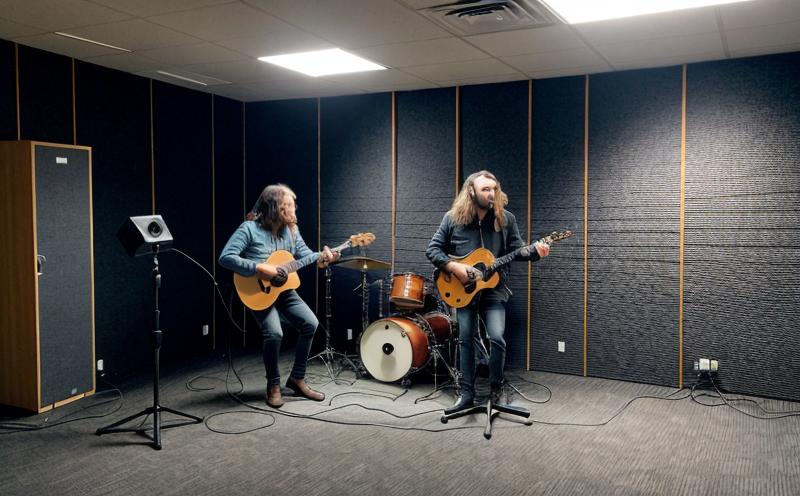ISO 10140-2 Laboratory Measurement of Sound Insulation
The ISO 10140-2 standard provides a method for the laboratory measurement of sound insulation in HVAC (Heating, Ventilation, and Air Conditioning) equipment. This service is critical for ensuring that HVAC systems meet stringent noise and sound insulation requirements as defined by international standards.
Sound insulation testing evaluates the ability of materials or components to reduce noise transmission between spaces, a key factor in HVAC design. Compliance with ISO 10140-2 ensures that HVAC equipment manufacturers can demonstrate their products’ performance under controlled laboratory conditions, which is essential for meeting regulatory requirements and market expectations.
The procedure involves placing the sample (typically a component of the HVAC system) between two sound chambers. White noise or pink noise is then generated in one chamber, and the reduction in sound power level across the partition is measured in the other chamber. The result provides a quantitative measure of the sound insulation performance of the HVAC equipment.
This testing method allows for precise measurement and comparison of different materials and designs, which is particularly important for specifying appropriate sound insulation solutions in various applications such as commercial buildings, hospitals, and residential complexes.
The accuracy and reliability of ISO 10140-2 testing are crucial to the design process. By identifying weak points early on, manufacturers can refine their products to meet stringent noise control requirements. This not only enhances product performance but also contributes significantly to overall acoustic comfort in HVAC installations.
Our state-of-the-art laboratory is equipped with advanced acoustic measurement systems that adhere strictly to ISO 10140-2 guidelines. Our team of experienced engineers and technicians ensures that every test conducted meets the highest standards for accuracy and repeatability. This commitment to precision translates directly into reliable data, which forms the basis for informed decision-making in product development.
Understanding the specific parameters involved in ISO 10140-2 testing is essential for quality managers, compliance officers, R&D engineers, and procurement specialists alike. By mastering these details, stakeholders can ensure that their HVAC equipment not only meets but exceeds industry expectations regarding sound insulation performance.
Industry Applications
The ISO 10140-2 Laboratory Measurement of Sound Insulation finds application across numerous sectors, including commercial buildings, healthcare facilities, residential complexes, and industrial plants. The following table highlights key areas where this testing is particularly important:
| Industry Sector | Application Context |
|---|---|
| Commercial Buildings | Evaluating HVAC components for noise reduction in open-plan office spaces and shared meeting rooms. |
| Hospitals | Ensuring that ventilation systems do not transmit noise into patient areas, enhancing the healing environment. |
| Residential Complexes | Testing HVAC equipment to minimize noise pollution in multi-family housing developments. |
| Industrial Plants | Evaluating sound insulation properties of HVAC units used in manufacturing environments. |
- Commercial Buildings: Testing is crucial for open-plan office spaces and shared meeting rooms to ensure noise levels are kept within acceptable limits.
- Hospitals: The focus here is on minimizing sound transmission into patient areas, which can significantly impact the healing environment.
- Residential Complexes: Ensuring that HVAC equipment in multi-family housing does not contribute to noise pollution.
- Industrial Plants: Evaluating the sound insulation properties of HVAC units used in manufacturing environments is essential for maintaining a quiet working atmosphere.
Environmental and Sustainability Contributions
The ISO 10140-2 testing plays an important role in promoting sustainable design practices, particularly within the HVAC industry. By ensuring that equipment meets stringent noise insulation standards, this service contributes to a quieter environment for both indoor and outdoor spaces.
A quieter environment translates directly into reduced energy consumption, as HVAC systems do not need to work as hard to maintain comfortable conditions when there is less ambient noise. This efficiency improvement leads to lower operational costs and reduced carbon emissions—a key goal in environmental sustainability efforts.
Moreover, by adhering to international standards such as ISO 10140-2, manufacturers can demonstrate their commitment to responsible product development, which enhances brand reputation among environmentally conscious consumers. This aligns with broader corporate social responsibility initiatives aimed at reducing the ecological footprint of industrial operations.
The testing also supports regulatory compliance and market demand for quieter HVAC systems. As consumer awareness about environmental issues grows, so does the expectation that businesses will adopt sustainable practices. ISO 10140-2 testing helps meet these expectations by providing clear, verifiable evidence of sound insulation performance.
Competitive Advantage and Market Impact
The ISO 10140-2 Laboratory Measurement of Sound Insulation offers significant competitive advantages to HVAC equipment manufacturers. By ensuring that their products meet or exceed the stringent noise insulation requirements set by this standard, companies can differentiate themselves in a crowded market.
Manufacturers who excel at sound insulation testing have an edge over competitors who do not, as they can offer quieter, more efficient systems that contribute positively to indoor and outdoor acoustic environments. This translates into enhanced customer satisfaction and loyalty, which are vital for long-term business success.
The ability to comply with international standards also opens doors to new markets and opportunities for expansion. Many regions have stringent noise regulations, and meeting these requirements can help manufacturers break into these markets more easily. Additionally, ISO 10140-2 testing enhances the reputation of a company as an industry leader in innovation and sustainability.
In summary, ISO 10140-2 testing is not just about compliance; it’s about setting new benchmarks for excellence in HVAC equipment design. This commitment to quality ensures that manufacturers can continue to innovate and meet evolving market demands, thereby driving their competitive advantage and market impact.





